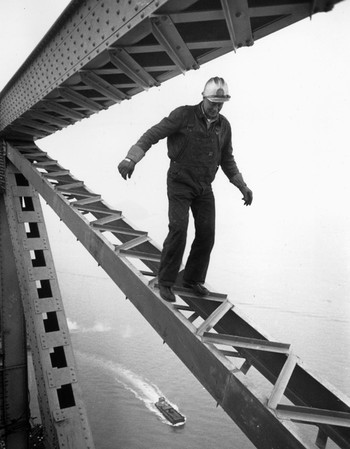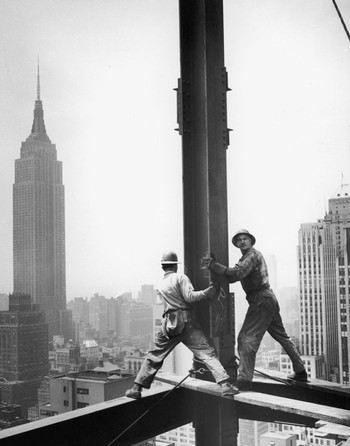In March, I attended a Donald Trump rally in St. Louis – or tried to, anyway. Arriving at 9:30 for a noon rally with ticket in hand, I assumed I would be early enough to make my way inside. I was wrong. The line surrounding the Peabody Opera House in downtown St. Louis went on for blocks. Thousands of Trump fans lined up with me, some telling me they had driven overnight from neighboring states to ensure they would see their hero. Protesters who I recognized from the Ferguson demonstrations stood near me in line undercover.
A construction worker balancing on a bridge girder high above San Francisco in California, c. 1955. Photo by Ernst Haas / Getty Images

After hours of waiting, thousands of us were shut out, left to linger in the plaza surrounding the opera house and listen to Trump’s voice through loudspeakers. The Trump fans, having calmly waited in line for hours, were now exhausted and furious that they could not attend, and they targeted their rage on the protesters.
“There’s nothing like a Trump rally,” Trump proclaimed joyfully, as fans and protesters fought each other both inside and outside the opera house.
There was extensive media coverage of the massive turnout at the St Louis rally, especially since it was followed by a similarly large rally in Chicago later that day (which was then canceled by Trump). Pundits cited the passion of both sides – the commitment to Trump and the commitment to stop him.
This is a man who knows how to exploit economic despair
But there was a more insidious factor that propelled the turnout in St Louis. Everyone with whom I spoke that day was either unemployed or working in part-time jobs. That is how thousands of Americans had the free time to wait in line, on a workday, for a Trump rally at noon.
Studio portrait of a bare-chested construction worker with glistening muscles, wearing a hard hat and holding thick rope coiled over one shoulder. Photo by Lambert / Getty Images

Trump has long made economic misery a staple of his campaign. His insistence that American work life has deteriorated is one of the few positions Trump shared with progressive Bernie Sanders, another populist candidate who drew massive crowds – indicating the extent of America’s economic despair. Trump has triumphed in part because of his ability to exploit Americans’ economic pain, speaking bluntly about underemployment as well as unemployment, and focusing on regions of the country often ignored by the mainstream media.
But on July 21, in Cleveland, as he made his first speech as the official nominee, he showed a blind spot – and a weakness.
“I have visited the laid-off factory workers, and the communities crushed by our horrible and unfair trade deals. These are the forgotten men and women of our country. People who work hard but no longer have a voice,” he proclaimed. He went on to say he would ease regulations to allow another category of workers – “the great miners and steel workers of our country” – to prosper again.
There is nothing wrong with advocating for better wages and opportunities for America’s manufacturing workers and miners – although it is disingenuous coming from Trump, who has been investigated for numerous fraud schemes and in the 1980s had to pay a settlement after illegally hiring hundreds of laborers from Poland and refusing to pay them in full.
Trump speaks to a nostalgic image of ‘the working man’
But the real weakness of Trump’s stance is that it reveals a complete disconnect from the nature of the economic misery most Americans experience. The majority of low-paid or underemployed U.S. workers are no longer in the manufacturing, mining, construction, or other male-dominated professions Trump routinely cites. They work in the service industry.
Working-class Americans rarely build things these days – they serve. Many are women, and many are not white
To be a working-class American today means to toil at McDonald’s, Walmart, or another giant retail or fast food outlet, often for wages so low even full-time employment puts you below the poverty line. A record 7.6% of all U.S. workers work in fast food, a rise which correlates with a rise in the number of employed workers on food stamps.
Some of these workers had good jobs and even flourishing careers before the 2008 recession caused middle-class jobs to disappear. Other service workers are young people locked out of the dwindling white-collar economy due to the inability to purchase expensive required credentials. (These vulnerable workers, in fact, were the targets of the Trump University scheme, which is being investigated for fraud.)
Working-class Americans rarely build things these days – they serve. Many of today’s working-class Americans are women, and many are not white. Trump’s vision of the working class is rooted in nostalgia for an era of traditionally masculine, physical labor that disappeared decades ago. At times it is literally a vision, illusory and false: When Trump ran an ad claiming “a working America is a winning America”, he used a stock photo of a Dutch model posing as a miner.

But what about the workers who change the sheets in Trump’s hotels?
Born rich and made richer, Trump shares no personal experience with working class people, but the machismo of manual labor is a quality with which he seeks to align.
New York construction workers are seen with the Empire State Building in the background, 1950. Photo by Ben McCall / FPG / Hulton Archive / Getty Images

Throughout the convention in Cleveland, Trump and his family members sought to distance themselves from their billionaire status by proclaiming affinity with the workers who help build Trump’s business empire. Over and over, we heard of Trump family members visiting construction sites, and saw images of Trump wearing a hard hat or standing near a crane.
“He hung out with the guys on construction sites […]. He listened to them and he valued their opinions as much and often more than the guys from Harvard and Wharton locked away in offices, away from the real work,” Trump’s son, Donald Jr., himself an Ivy League-educated businessman, proclaimed.
But which Trump workers did we not hear about? The janitors who sweep Trump’s offices. The maids who change Trump’s hotel sheets. The waitresses who serve the tacos he presents as evidence that he “loves Hispanics.” The cashiers who run the register at his gift shops.
The service workers who dominate the U.S. economy are invisible to Trump, because he is blinded by nostalgia.
Trump can use a shot of their toughness
The GOP convention was a four-day fear-fest, concentrating on crime and terror, and promoting Trump as a “law and order” candidate in a manner many compared to Richard Nixon – a comparison Trump made himself as well.
The Nixon comparison is apt, but not in the way Trump intended. His economic prescriptions are aimed at the workers of Nixon’s early 1970s economy – predominately white male factory workers and miners. These workers, too, suffer badly in today’s economy, but they now are a small fragment of the working population compared to the service industry workers Trump ignores, and to whom he could never feign a convincing affinity.
Trump tries to align himself with physical laborers because he wants to emulate their toughness – their image bolsters his own
Trump’s speech, brimming with bigoted bromides over “illegal immigrants…roaming free to threaten peaceful citizens” and proclamations of himself as our sole savior, terrified his opponents and electrified his base. Some pundits lauded his ability to channel working class rage.
A workman peers through a ring spanner or wrench, 1994. Photo by Alfred Gescheidt / Getty Images

But these pundits are also blind to working class reality. The new American underclass does not tip their hard hats and flex their muscle – they greet you with forced smiles and suffer silently as they serve. Employed in powerless positions, often in traditionally female-dominated fields, they are disrespected and dismissed despite their hard work and physical stamina. They are often forced to take more than one service job because wages are too low in these industries to support a family.
Trump’s view of their plight? “Wages are too high,” he said in November, when asked about the Democrats’ plan to raise the minimum wage. “I hate to say it, but we have to leave it the way it is.”
In his July 21 speech, Trump made two claims: “I am your voice” and “I am with you.” This is the echo chamber of a dictator, reverberating back to the glorification of Trump himself. Trump tries to align himself with physical laborers because he wants to emulate their toughness – their image bolsters his own. But workers from whom he cannot personally benefit are dismissed or ignored.
And it is here, with a platform that seeks to raise minimum wage and extend the social safety net, that the Democrats may reveal Trump’s vision of the working class for what it is – the blindness of a rich white man.
More from The Correspondent:
 On the ground in Flyover Country
Much of our news comes from the East or the West Coast. But what about that vast space in between, the ‘Flyover Country’? Home to more than half the nation’s people, it is here in the American heartland that presidents are made. Join me in the run-up to the November election, as I report on the U.S. from Middle America.
On the ground in Flyover Country
Much of our news comes from the East or the West Coast. But what about that vast space in between, the ‘Flyover Country’? Home to more than half the nation’s people, it is here in the American heartland that presidents are made. Join me in the run-up to the November election, as I report on the U.S. from Middle America.
 What I had to tell my daughter about the America of her black classmates
For centuries, black Americans have been systematically brutalized. Now that we have video evidence – going viral – you would expect things to change. But even video cannot open the eyes of those who refuse to see.
What I had to tell my daughter about the America of her black classmates
For centuries, black Americans have been systematically brutalized. Now that we have video evidence – going viral – you would expect things to change. But even video cannot open the eyes of those who refuse to see.
 This is what goes wrong inside your head every day
Thanks to our ability to grasp objects and to grasp language – tasks at which our left brain excels – we humans rule the planet. But why do things sometimes go so absurdly wrong? A cautionary tale of what gets skewed within our skulls and what we can do about it.
This is what goes wrong inside your head every day
Thanks to our ability to grasp objects and to grasp language – tasks at which our left brain excels – we humans rule the planet. But why do things sometimes go so absurdly wrong? A cautionary tale of what gets skewed within our skulls and what we can do about it.
 What’s deadly dull and can save the world? (Hint: We can’t stand it)
What do poor people need most? Food? Healthcare? Education? The answer is as surprising as it is simple. And it can be found under fluorescent lights and modular ceilings.
What’s deadly dull and can save the world? (Hint: We can’t stand it)
What do poor people need most? Food? Healthcare? Education? The answer is as surprising as it is simple. And it can be found under fluorescent lights and modular ceilings.



